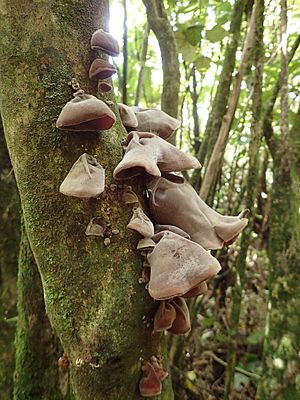Cloud ear facts for kids
Quick facts for kids Cloud ear |
|
|---|---|
 |
|
| Auricularia cornea, New Zealand | |
| Scientific classification | |
| Synonyms | |
|
Auricularia cornea is a special type of fungus that looks a bit like an ear! People often call it the cloud ear or hairy wood ear. It belongs to a group of fungi called Auriculariales. This fungus is grown a lot in China and is a popular ingredient in many Chinese dishes. It is also used in traditional Chinese medicine.
Contents
What is Auricularia cornea?
How Scientists Name Fungi
Auricularia cornea was first described by a German scientist named Christian Gottfried Ehrenberg in 1820. He found it in Hawaii. Later, in 1952, another scientist named Bernard Lowy confirmed it was a unique species. Modern science, using DNA studies, has also shown it is its own distinct type of fungus.
Another fungus, Auricularia polytricha, might actually be the same species. It was described in India in 1834. Scientists are still studying if they are truly identical.
Different Names for the Cloud Ear
This fungus has many interesting names around the world!
- In Mandarin Chinese, it's called yún'ěr (云耳), which means "cloud ear".
- It's also known as máomù'ěr (毛木耳), meaning "hairy wood ear".
- In Japanese, it's called ara-ge-ki-kurage (アラゲキクラゲ), meaning "rough-hair-tree-jellyfish".
- Many people simply call it wood ear, wood fungus, or tree ear fungus. This is because it looks like a rubbery ear growing on trees.
In Hawaii, it's called pepeiao, which means "ear". In Southeast Asia, it's known as bok née. This name comes from the Hokkien Chinese language. In Indonesia and Malaysia, it's called jamur kuping, meaning "the ear mushroom". In the Philippines, it's called tenga ng daga, meaning "rat's ear", because of how it looks. In Chinese cuisine, it's sometimes called "Black Treasure". The Māori people in New Zealand call it hakeke.
There's even a white version of Auricularia cornea that is grown in China. It's called yumuer.
What Does It Look Like?
Appearance of the Fruit Body
The parts of the fungus you can see are called fruit bodies. They can grow alone or in groups. They are shaped like an ear and attach to wood, sometimes with a very short stem. They feel elastic and a bit like jelly. Their color can be pale brown to reddish-brown, but sometimes they are white. They can grow up to 90 mm wide and 2 mm thick.
The top surface of the fungus is usually quite hairy. The underside is smooth. If you look very closely with a powerful microscope, you can see the tiny hairs on the top surface.
Where Does It Grow?
Habitat and Global Distribution
Auricularia cornea grows on dead trees. You can find it on fallen logs or standing dead trees, especially broadleaf trees. This fungus is found in many parts of the world. It grows in southern Asia, Africa, Australia, New Zealand, the Pacific islands, and South America.
How Do People Use It?
Cooking with Cloud Ear Fungus
Auricularia cornea is usually sold dried. Before you can use it in cooking, you need to soak it in water. It doesn't have much taste on its own. However, people love it for its unique texture. It's slippery but also a little bit crunchy, even after it's cooked!
This type of fungus is a bit tougher than some other "wood ear" fungi. Because of this, it's often used in soups rather than stir-fries.
Traditional Uses and Health Benefits
The Māori people in New Zealand traditionally cooked this fungus in an earth oven. They would eat it with sow thistle and potatoes. From the 1870s to the 1950s, this fungus was even collected in New Zealand and sent to China for sale.
In traditional Chinese medicine, people believe that eating dried and cooked wood ear fungus can be good for your health. They suggest it might help people with high blood pressure or certain types of cancer. It is also thought to help prevent heart problems.
This fungus is also used in some Cantonese desserts. It is also a good source of dietary fibre. A cup of dry cloud ear fungus contains almost 20 grams of fiber!
Images for kids


